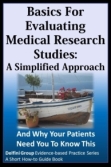 Click™
Click™ 

A Cool Click for Evidence-based Medicine (EBM) and Evidence-based Practice (EBP) Commentaries & Health Care Quality Improvement Nibblets
The EBM Information Quest: Is it true? Is it useful? Is it usable?™
Valdity Detectives: Michael E Stuart MD, President & Medical Director . Sheri Ann Strite, Managing Director & Principal

Why Critical Appraisal Matters
DelfiniClick™Evidence & Quality Improvement Commentaries |
Follow & Share...
DelfiniGram™: GET ON OUR UPDATE LIST ![]()
Volume
— Use of Evidence: newest 01/05/2015: Network Meta-analyses—More Complex Than Traditional Meta-analyses Contents
|
|||||||||
Institute of Medicine CEO Checklist for High-Value Healthcare In June, 2012 the Institute of Medicine (IOM) published a checklist for healthcare CEOs as a way of encouraging further efforts towards achieving a simultaneous reduction in costs and elimination of waste.[1] EBMers will find the case studies of great interest. Many of the success stories contain two key ingredients—reliable information to improve decision-making and successful implementation. The full report is available at— Foundational Elements 1. Governance priority—visible and determined leadership by CEO and board
2. Information technology (IT) best practices—automated, reliable information to and from the point of care
3. Care Delivery Priorities
4. Reliability and Feedback
References 1. Cosgrove D, Fisher M, Gabow P, et al. A CEO Checklist for High-Value Health Care. Discussion paper. Washington, DC: Institute of Medicine; 2012. https://nam.edu/wp-content/uploads/2015/06/CEOHighValueChecklist.pdf (accessed 08/13/2012).
|
|||||||||
|
"Lies,
Damned Lies, and Medical Science," by David H. Freedman,
The Atlantic, November 2010
|
|||||||||
How
to Evaluate Medical Science We applaud David H. Freedman’s “Lies, Damned Lies, and Medical Science” (November Atlantic), having long been admirers of professor John Ioannidis. We too evaluate medical evidence and train physicians and others in how to analyze studies for reliability and clinical usefulness. However, we believe the problem is larger, and the consequences of applying the results of misleading science more deleterious, than implied. Low-quality science significantly contributes to lost care opportunities, illness burden, and mortality. For instance, in the 1980s, observational studies “reported” dramatic tumor shrinkage and reduced mortality in women with advanced breast cancer who were treated with high-dose chemotherapy and autologous bone-marrow transplant. But these studies are highly prone to bias; valid randomized controlled trials are required to prove efficacy of therapies. More than 30,000 women underwent these procedures before randomized controlled trials showed greater adverse events and mortality. And we believe less than 10 percent of such trials are reliable. Individual biases have been shown to greatly distort study results, frequently in favor of the new treatment being studied. Yet few health-care professionals know the importance of bias in studies, or the basics of identifying it, and so are at high risk of being misled. In an informal tally, roughly 70 percent of physicians fail our basic test for critical appraisal, which should be a foundational discipline for all health-care professionals. Sheri Ann Strite |
|||||||||
Full Delfini Commentary on "Lies, Damned Lies, and Medical Science," by David H. Freedman, The Atlantic, November 2010 We have long been admirers of Professor John Ioannidis and routinely cite his important PLoS article, “Why Most Published Research Findings are False,” in our training programs.[1] We were excited to see him featured in The Atlantic in David Freedman’s important article, "Lies, Damned Lies, and Medical Science," which you can read here. One of the main points in the article is that Professor Ioannidis “…charges that as much as 90 percent of the published medical information that doctors rely on is flawed.” We are hopeful that this important piece casts a spotlight on the problem of flawed and potentially misleading medical science that we continue to raise wherever and however we can. However—and importantly—we believe the problem of the creating and using of potentially misleading science to be much, much larger than expressed in the article, and we believe the consequences to the public are much, much greater than implied. It is our experience having reviewed hundreds of clinical trials that roughly 90 percent of randomized controlled trials—forget the observations!—are not only flawed, but are so flawed that they are not reliable or clinically useful. So the reality is even worse, in our estimation. And the documentation of resulting patient harms is significant and significantly underreported. Adding to this problem is that the vast majority of physicians, clinical pharmacists and other healthcare professionals have no idea how to evaluate a study in even a basic way (informally, roughly over 70 percent of doctors fail our simple 3-question critical appraisal pre-test). If they have even basic skills, we believe they would be able to dodge maybe as high as 75 percent of potentially misleading clinical trial results, or more. Care for patients would be much better and waste much reduced. (Major groups have estimated that somewhere in the neighborhood of 20 to 50 percent of care in the US is inappropriate.[2-6] That translates into at least one hundred billion dollars each year.) Ironically, it is relatively easy to learn basic critical appraisal skills. Yet, schools generally do not provide effective training in how to conduct studies that are likely to yield valid and useful science and—possibly more importantly—in how to critically appraise the medical literature and apply it. A big issue is that it is from this untrained pool that many of our researchers come, not to mention editors and peer-reviewers (and future academicians). In writing the World Association of Medical Editors in 2007 about their lack of critical appraisal criteria, we received the following response: “Thanks for your interest…regarding the issue of inaccuracy and error in the medical literature (and in fact in all scientific literature). You are correct that this is a large problem. No doubt it exists partly because many reviewers, editors, and authors lack skill, training, and understanding in these issues.”[7] If healthcare professionals are not competent in evaluating primary studies (original studies such as RCTs) they will not be able to determine if study results are reliable. The problem is carried further: when they read secondary studies (systematic reviews and meta-analyses) without critical appraisal skills, they will be unable to determine if the included primary studies are reliable. And they will have the same problem evaluating secondary sources (guidelines and other derivative works such as monographs and textbooks). The entire culture of medicine and healthcare needs to change to one in which effective evidence-based practice is the norm with a true understanding of what that really means. This will not be easy because, unfortunately, the magnitude and severity of the problem is not widely appreciated and frequently the concept of evidence-based practice is misunderstood. It all starts with our schools. This article casts light on the tip of a very big and dangerous iceberg, and we are thankful to Dave Freedman for writing it and for Professor Ioannidis for all his important work including participating with Dave in this story. References 1. Ioannidis JPA. Why Most Published Research Findings are False. PLoS Med 2005; 2(8):696-701. PMID 17593900. 2. Chassin MR, Galvin RW (1998) The National Roundtable on Health Care Quality. The urgent need to improve health care quality: Institute of Medicine National Roundtable on Health Care Quality [consensus statement]. JAMA 280:1000–1005. 3. McGlynn EA, Asch SM, Adams J, Keesey J, Hicks J et al. (2003) The quality of health care delivered to adults in the United. N Engl J Med 348:2635-45. 4. Kerr EA,
McGlynn EA, Adams J, Keesey J, Asch SM (2001) Profiling the quality
of care 5. Skinner J, Fisher ES, Wennberg JE (2001) For the National Bureau of Economic Research. The efficiency of Medicare. Working Paper No. 8395. Cambridge, MA: National Bureau of Economic Research. Available: papers.ssrn.com/sol3/papers.cfm?abstract_id=277305. Accessed 13 January 2010. 6. Centers for Medicare and Medicaid Services, Office of the Actuary, National Health Statistics Group, National Health Care Expenditures Data, January 2010. 7. Personal correspondence from WAME, World Association of Medical Editors.
|
|||||||||
De-adopting Ineffective or Harmful Clinical Practices Although a fair amount is known about diffusion and adoption of new ideas and practices, less is known about the abandonment of practices that are ineffective or harmful ("undiffusion"). We want to draw your attention to a recent editorial that address this issue [Davidoff]. Here are some of the take-home points:
Some of the interesting concepts, examples and case studies explored in the editorial include—
Delfini Comment Reference Davidoff F. On the Undiffusion of Established Practices. JAMA Intern Med. 2015 Mar 16. doi: 10.1001/jamainternmed.2015.0167. [Epub ahead of print] PubMed PMID: 25774743.
|
|||||||||
| Sounding the Alarm (Again) in Oncology 12/06/2014 Five years ago Fojo and Grady sounded the alarm about value in many of the new oncology drugs [1]. They raised the following issues and challenged oncologists and others to get involved in addressing these issues:
The authors review a number of oncology drug studies reporting increased overall survival (OS) ranging from a median of a few days to a few months with total new drug costs ranging from $15,000 to $90,000 plus. In some cases, there is no increase in OS, but only progression free survival (PFS) which is a weaker outcome measure due to its being prone to tumor assessment biases and is frequently assessed in studies of short duration. Adverse events associated with the new drugs are many and include higher rates of febrile neutropenia, infusion-related reactions, diarrhea, skin toxicity, infections, hypertension and other adverse events. Fojo and Grady point out that—
In a recent article [2] (thanks to Dr. Richard Lehman for drawing our attention to this article in his wonderful BMJ blog) Fojo and colleagues again point out that—
The last bullet needs a little explaining. The authors provide a number of examples of “safe bets” and argue that revenue from such safe and profitable therapies rather than true need has been a driving force for new oncology drugs. The problem is compounded by regulations—e.g., rules which require Medicare to reimburse patients for any drug used in an “anti-cancer chemotherapeutic regimen"—regardless of its incremental benefit over other drugs—as long as the use is “for a medically accepted indication” (commonly interpreted as “approved by the FDA”). This provides guaranteed revenues for me-too drugs irrespective of their marginal benefits. The authors also point out that when prices for drugs of proven efficacy fall below a certain threshold, suppliers often stop producing the drug, causing severe shortages.
Delfini Comment And so, as pointed out by Fojo et al., only small gains have been made in OS over the past 12 years, and costs of oncology drugs have skyrocketed. However, to make matters even worse than portrayed by Fojo et al., many of the oncology drug studies we see have major threats to validity (e.g., selection bias, lack of blinding and other performance biases, attrition and assessment bias, etc.) raising the question, "Does the approximate 2 month gain in median OS represent an overestimate?" Since bias tends to favor the new intervention in clinical trials, the PFS and OS reported in many of the recent oncology trials may be exaggerated or even absent or harms may outweigh benefits. On the other hand, if a study is valid, since a median is a midpoint in a range of results and a patient may achieve better results than indicated by the median, some patients may choose to accept a new therapy. The important thing is that patients are given information on benefits and harms in a way that allows them to have a reasonable understanding of all the issues and make the choices that are right for them. Resources & References
|
|||||||||
| Involving Patients in their Care Decisions and JAMA Editorial: The New Cholesterol and Blood Pressure Guidelines: Perspective on the Path Forward 04/08/2014 Krumholz HM. The New Cholesterol and Blood Pressure Guidelines: Perspective on the Path Forward. JAMA. 2014 Mar 29. doi: 10.1001/jama.2014.2634. [Epub ahead of print] PubMed PMID: 24682222. http://jama.jamanetwork.com/article.aspx?articleid=1853201 Here is an excellent editorial that highlights the importance of patient decision-making. We thank the wonderful Dr. Richard Lehman, MA, BM, BCh, Oxford, & Blogger, BMJ Journal Watch, for bringing this to our attention. We have often observed that evidence can be a neutralizing force. This editorial highlights for us that this means involving the patient in a meaningful way and finding ways to support decisions based on patients' personal requirements. These personal "patient requirements" include health care needs and wants and a recognition of individual circumstances, values and preferences. To achieve this, we believe that patients should receive the same information as clinicians including what alternatives are available, a quantified assessment of potential benefits and harms of each including the strength of evidence for each and potential consequences of making various choices including things like vitality and cost. Decisions may differ between patients, and physicians may make incorrect assumption about what most matters to patients of which there are many examples in the literature such as in the citations below. O'Connor A. Using patient decision aids to promote evidence-based decision making. ACP J Club. 2001 Jul-Aug;135(1):A11-2. PubMed PMID: 11471526. O’Connor AM, Wennberg JE, Legare F, Llewellyn-Thomas HA,Moulton BW, Sepucha KR, et al. Toward the 'tipping point’: decision aids and informed patient choice. Health Affairs 2007;26(3):716-25. Rothwell PM. External validity of randomised controlled trials: "to whom do the results of this trial apply?". Lancet. 2005 Jan 1-7;365(9453):82-93. PubMed PMID: 15639683. Stacey D, Bennett CL, Barry MJ, Col NF, Eden KB, Holmes-Rovner M, Llewellyn-Thomas H, Lyddiatt A, Légaré F, Thomson R. Decision aids for people facing health treatment or screening decisions. Cochrane Database Syst Rev. 2011 Oct 5;(10):CD001431. Review. PubMed PMID: 21975733. Wennberg JE, O'Connor AM, Collins ED, Weinstein JN. Extending the P4P agenda, part 1: how Medicare can improve patient decision making and reduce unnecessary care. Health Aff (Millwood). 2007 Nov-Dec;26(6):1564-74. PubMed PMID: 17978377.
|
|||||||||
Gastro-esophageal
Reflux Disease (GERD), The Purple Pill and Plenty of Pennies We thought we would pass on some information about PPIs, having been asked by a medical director friend of our what we thought about Nexium®—aka the controversy concerning the purple pill (esomeprazole) versus Prilosec (omeprazole) when considering comparative efficacy and cost. Our friend mentioned that he was concerned because Nexium costs about $5.60 per pill and Prilosec costs about 60 cents per pill, and some of his physicians believe that Nexium is more effective for GERD (gastro-esophageal reflux disease) than Prilosec. Background: In the 1980s, proton pump inhibitors (PPIs) were quickly adopted for reducing symptoms associated with gastric hyperacidity, e.g., heartburn and reflux symptoms. Priolosec® (omeprazole) was to go off patent in 2001, and generic omeprazole would become available at a lower cost. In 2000 a trial, “Esomeprazole improves healing and symptom resolution as compared to omeprazole in reflux oesophagitis: a randomized controlled trial [1],” concluded that, “Esomeprazole was more effective than omeprazole in healing and symptom resolution in GERD patients with reflux oesophagitis, and had a tolerability profile comparable to that of omeprazole.” In this trial, 1960 patients with endoscopy-confirmed reflux esophagitis were randomized to once daily esomeprazole 40 mg (n= 654) or 20 mg (n= 656), or omeprazole 20 mg (n=650) for up to 8 weeks. What We Found: This study had a few flaws. For example, details of randomization were not reported and baseline characteristics differed with more patients with mild (versus more severe) esophagitis in the esomeprazole 40 mg group than in the omeprazole 20 mg group. Four of the 9 authors were from Astra Zeneca, and the study was supported by a grant from Astra Zeneca. (We do not reject studies because of industry involvement, but we do pay attention to this.) Three subsequent trials using the same doses of the two drugs were also conducted, and two of the three trials reported statistically significant differences in symptom relief (favoring esomeprazole) with a pooled estimate of effect of an 8%, 95% CI (3% to 13%) difference in the proportion of subjects achieving resolution of GERD symptoms. This and other information found in a very helpful recent OHSU review of PPIs paint a more complete picture of the comparative efficacy of omeprazole compared to esomeprazole (and other PPIs) [2]:
“Is esomeprazole really clinically superior to omeprazole in reducing symptoms in patients with symptoms of GERD (gastro-esophageal reflux disease or healing rates in esophagitis?” Our conclusion: There is insufficient evidence to conclude that there are meaningful clinical differences between omeprazole (Prilosec) and esomeprazole (Nexium) when given in comparable doses for symptom relief or healing of heartburn or esophagitis. Resolution of symptoms and healing rates are very high with either drug—in the neighborhood of 75 percent. The cost differences, however, are significant. References 2. The most useful systematic review we could find comes from Oregon Health Sciences University (OHSU) Center for Evidence-based Policy: (http://derp.ohsu.edu/about/final-document-display.cfm). Accessed 7/13/10.
|
|||||||||
Guidelines & Effectiveness of Implementation Tremendous effort goes into the development of high quality clinical guidelines and effective disease management programs. But, there is much uncertainty about how to effectively implement the final product — the evidence-based clinical improvements. In this systematic review, Weingarten et al report that clinicians do change their practice based on provider education efforts, among other strategies. Click to learn more about improvements in care directed at clinicians and patients. Link to the Abstract (Full Text Available) BMJ 2002;325:925 ( 26 October ) Weingarten S. et al. Interventions used in disease management programmes for patients with chronic illness — which ones work? Meta-analysis of published reports. http://bmj.com/cgi/content/abstract/325/7370/925
|
|||||||||
Oregon Preferred Drug List: Conference Report "Adding Value to the Cost Equation with Prescription Drugs: The Oregon Experience" — Tuesday, February 25th, Seattle Washington Mike was on a panel, including many notables. Keynote address was by John Kitzhaber, MD, Former Governor, State of Oregon. The conference was a great success. Read about the program. To access, copy the
following into an internet search engine:
|
|||||||||
Delfini Introduction Generally, we advise people to measure — not health status outcomes — but to perform a process measurement to evaluate the success of application of the intervention. In other words, we advise people to measure the success of implementation of the clinical improvement. For example, if we are trying to ensure patients get a beta-blocker post-MI, we would recommend looking to see if prescriptions increased for hospitalized MI patients — not to measure whether patient survival was improved. This is because observational data, such as information extracted from databases, can be highly prone to confounding. If health status outcomes are measured, then we advise people to ensure that there is a sufficient understanding of all those utilizing the data that conclusions drawn from observational data can be misleading. In the above example, if patient survival decreased, there could be many explanations. However, if a health status outcome is measured, and if the before/after change is dramatic, it is reasonable to hypothesize that our project has been successful. For example… Problem Evidence-based QI Project: A quality improvement group at Dreyer Medical Clinic developed a disease management initiative using PharmDs to actively titrate dosages of insulin and other drugs based on the Intermountain Health Care (IHC) diabetes management protocol. The process is as follows:
Outcomes
Delfini Commentary It is reasonable to believe that the clinical improvement project was successful. Using outcomes data from the UK Prospective Diabetes Study 35 (1), the QI team estimates that since inception, the disease management initiative resulted in the prevention of —
1. Stratton, I,M., Adler, A.I., et al, Association of glycaemia with macrovascular and microvascular complications of type 2 diabetes (UKPDS 35): prospective observation study. BMJ 2000; 321; 405-12.
|
|||||||||
| External
Validity: Case of the Carotid Stent
The lead article in the Oct. 7, 2004 issue of The New England Journal of Medicine, (Yadav JS, Wholey MH, Kuntz RE, et al. Protected Carotid-Artery Stenting versus Endarterectomy in High-Risk Patients N Engl J Med 2004;351:1493-501 — PMID: 15470212 — abstract), known as the SAPPHIRE trial, is an RCT with what appears to be adequate randomization/concealment of allocation, similar baseline characteristics of subjects, adequate blinding and with intention to treat analysis comparing carotid stenting using an embolic protection device to endarterectomy in patients with symptomatic carotid stenosis of at least 50 percent or asymptomatic stenosis of at least 80 percent and at least one high risk factor such as recurrent stenosis after endarterectomy e.g., age>80, cardiac disease or other significant medical problems. More than 20% of the patients in both treatment groups were patients with recurrent stenosis after endarterectomy. The primary end point was a composite of death, stroke or MI within 30 days after the intervention, or death or ipsilateral stroke between 31 days and 1 year. The study appeared to be a sufficiently powered equivalence study. Study team members included both a surgeon and an interventionist who could prevent randomization of enrolled subjects if, in their judgment, the procedures could not be performed safely in these high risk patients. 747 patients were enrolled and 334 underwent randomization. The primary endpoint occurred in 20 patients in the stenting group (12.2 percent) and in 32 in the endarterectomy group (20.1%), yielding a P value of 0.004 for non-inferiority. At one year, revascularization was repeated in 0.6 percent of the stent patients and 4.3 percent of the endarterectomy patients; P=0.04. The authors conclude that in patients with severe carotid-artery stenosis and coexisting conditions, carotid stenting with an emboli protection device is not inferior to carotid endarterectomy. Question Our Answer
|
|||||||||
Update on Decision Support for Clinicians and Patients We have written extensively and provide many examples of decision support materials on our website. An easy way to round them up is to go to our website search window http://www.delfini.org/index_SiteGoogleSearch.htm and type in the terms “decision support.” A nice systematic review of the topic funded by AHRQ—Clinical Decision Support Systems (CDSSs)— has recently been published in the Annals of Internal Medicine.[1] The aim of the review was to evaluate the effect of CDSSs on clinical outcomes, health care processes, workload and efficiency, patient satisfaction, cost, and provider use and implementation. CDSSs include alerts, reminders, order sets, drug-dose information, care summary dashboards that provide performance feedback on quality indicators, and information and other aids designed to improve clinical decision-making. Findings: 148 randomized controlled trials were included in the review. A total of 128 (86%) assessed health care process measures, 29 (20%) assessed clinical outcomes, and 22 (15%) measured costs. Both commercially and locally developed CDSSs improved health care process measures related to performing preventive services (n =25; odds ratio [OR] 1.42, 95% CI [1.27 to 1.58]), ordering clinical studies (n=20; OR 1.72, 95% CI [1.47 to 2.00]), and prescribing therapies (n=46; OR 1.57, 95% CI [1.35 to 1.82]). There was heterogeneity in interventions, populations, settings and outcomes as would be expected. The authors conclude that commercially and locally developed CDSSs are effective at improving health care process measures across diverse settings, but evidence for clinical, economic, workload and efficiency outcomes remains sparse. Delfini Comment: Although this review focused on decision support systems, the entire realm of decision support for end users is of great importance to all health care decision-makers. Without good decision support, we will all make suboptimal decisions. This area is huge and is worth spending time understanding how to move evidence from a synthesis to decision support. Interested readers might want to look at some examples of wonderful decision support materials created at the Mayo Clinic. The URL is— http://webpages.charter.net/vmontori/Wiser_Choices_Program_Aids_Site/Welcome.html Reference 1. Bright TJ, Wong A, Dhurjati R, Bristow E, Bastian L, Coeytaux RR, Samsa G, Hasselblad V, Williams JW, Musty MD, Wing L, Kendrick AS, Sanders GD, Lobach D. Effect of clinical decision-support systems: a systematic review. Ann Intern Med. 2012 Jul 3;157(1):29-43. PubMed PMID: 22751758.
|
|||||||||
Divulging Information to Patients With Poor Prognoses We have seen several instances where our colleagues’ families have been given very little prognostic information by their physicians in situations where important decisions involving benefits versus harms, quality of life and other end of life decisions must be made. In both cases when a clinician in the family presented the evidence and prognostic information, decisions were altered. We were happy to see a review of this topic by Mack and Smith in a recent issue of the BMJ.[1] In a nutshell the authors point out that—
Patients and families want prognostic information which is required to make decisions that are right for them. This together with the lack of evidence that discussing prognosis causes depression, shortens life, or takes away hope and the huge problem of unnecessary interventions at the end of life creates a strong argument for honest communication about poor prognoses. Reference 1. Mack JW, Smith TJ. Reasons why physicians do not have discussions about poor prognosis, why it matters, and what can be improved. J Clin Oncol. 2012 Aug 1;30(22):2715-7. Epub 2012 Jul 2. PubMed PMID: 22753911.
|
|||||||||
Network Meta-analyses—More Complex Than Traditional Meta-analyses Meta-analyses are important tools for synthesizing evidence from relevant studies. One limitation of traditional meta-analyses is that they can compare only 2 treatments at a time in what is often termed pairwise or direct comparisons. An extension of traditional meta-analysis is the "network meta-analysis" which has been increasingly used—especially with the rise of the comparative effectiveness movement—as a method of assessing the comparative effects of more than two alternative interventions for the same condition that have not been studied in head-to-head trials. A network meta-analysis synthesizes direct and indirect evidence over the entire network of interventions that have not been directly compared in clinical trials, but have one treatment in common. Example Network meta-analyses, also known as “multiple-treatments meta-analyses” or “mixed-treatment comparisons meta-analyses” include both direct and indirect evidence. When both direct and indirect comparisons are used to estimate treatment effects, the comparison is referred to as a "mixed comparison." The indirect evidence in network meta-analyses is derived from statistical inference which requires many assumptions and modeling. Therefore, critical appraisal of network meta-analyses is more complex than appraisal of traditional meta-analyses. In all meta-analyses, clinical and methodological differences in studies are likely to be present. Investigators should only include valid trials. Plus they should provide sufficient detail so that readers can assess the quality of meta-analyses. These details include important variables such as PICOTS (population, intervention, comparator, outcomes, timing and study setting) and heterogeneity in any important study performance items or other contextual issues such as important biases, unique care experiences, adherence rates, etc. In addition, the effect sizes in direct comparisons should be compared to the effect sizes in indirect comparisons since indirect comparisons require statistical adjustments. Inconsistency between the direct and indirect comparisons may be due to chance, bias or heterogeneity. Remember, in direct comparisons the data come from the same trial. Indirect comparisons utilize data from separate randomized controlled trials which may vary in both clinical and methodological details. Estimates of effect in a direct comparison trial may be lower than estimates of effect derived from indirect comparisons. Therefore, evidence from direct comparisons should be weighted more heavily than evidence from indirect comparisons in network meta-analyses. The combination of direct and indirect evidence in mixed treatment comparisons may be more likely to result in distorted estimates of effect size if there is inconsistency between effect sizes of direct and indirect comparisons. Usually network meta-analyses rank different treatments according to the probability of being the best treatment. Readers should be aware that these rankings may be misleading because differences may be quite small or inaccurate if the quality of the meta-analysis is not high. Delfini Comment References Salanti G, Del Giovane C, Chaimani A, Caldwell DM, Higgins JP. Evaluating the quality of evidence from a network meta-analysis. PLoS One. 2014 Jul 3;9(7):e99682. doi: 10.1371/journal.pone.0099682. eCollection 2014. PubMed PMID: 24992266.
|
At DelfiniClick™
Menu........
Use of our website implies agreement to our Notices. Citations for references available upon request.
Home
Best of Delfini
What's New
Blog
Seminars
Services
Delfini Group Publishing
Resources
Sample Projects
Notices
About
Us & Our Work
Testimonials
Other
Site Search
Contact
Info/Updates
........
Quick Navigator to Selected Resources
- Tools & Educational Library
- The Healthcare Information Problem
- Tutorials
- DelfiniClick™—commentaries
- On the Same Page™—patient decision support
- Evidence Messaging Scripts
- Delfini Publications
- Medical Leader Interviews
- Glossary
- Recommended Reading
- Recommended Web Links
- Delfini Critical Appraisal Flier
- Get DelfiniGram™ Updates
.......................








